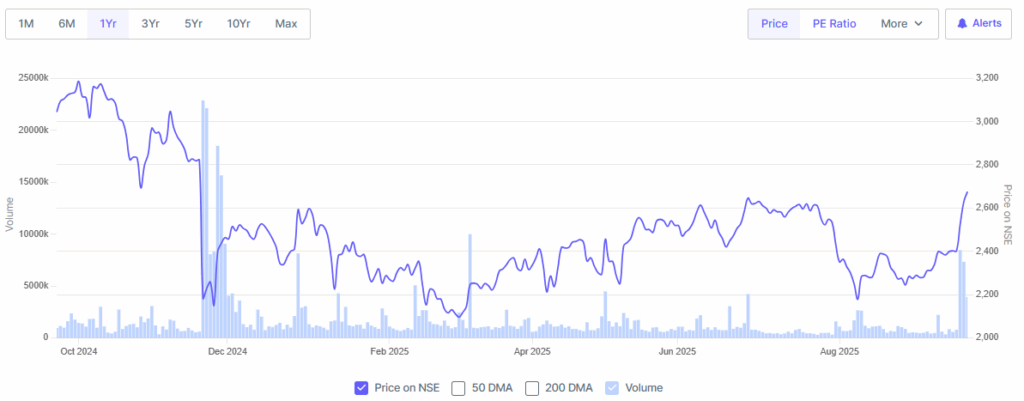Adani Stock Split: What’s Driving the 20% Jump in Share Price?
The Adani Stock has recently captured global investor attention after a remarkable 20% surge in its share price. The spike came on the back of a much-anticipated stock split announcement, which has reshaped investor sentiment and triggered widespread market discussions.
Understanding the Adani Stock Split
A stock split occurs when a company increases the number of its outstanding shares by issuing more shares to current shareholders. While this does not change the overall market capitalization, it reduces the price per share, making the stock more affordable to retail investors.
Adani’s decision to split its stock has created a buzz, as the move effectively enhances liquidity and broadens access for smaller investors. This shift often leads to increased trading volumes, heightened visibility, and improved market participation. The psychological effect of lower prices, combined with strong corporate performance, typically adds momentum to the stock’s trajectory.
Why Did Adani Stock Jump After the Split?
The 20% rise in Adani’s share price is not simply a coincidence. There are several factors behind this surge:
- Accessibility for Small Investors
A reduced share price after the split allows more retail investors to enter the market. The affordability factor is crucial in emerging markets, where smaller investors play a significant role in daily trading activity. - Boost in Liquidity
With more shares in circulation, the stock becomes more liquid, attracting institutional investors who prefer trading in highly liquid counters. This has given the Adani stock greater visibility in the stock market. - Positive Sentiment from Corporate Governance Moves
Adani’s recent efforts to improve transparency, manage debt efficiently, and diversify operations across infrastructure, energy, and logistics have reassured investors. The stock split is seen as part of this broader strategy to strengthen investor confidence. - Broader Market Optimism
The rally also comes at a time when global investors are turning toward emerging markets, particularly India, due to its robust growth outlook. This macroeconomic backdrop amplified the effect of the split announcement.

Impact of Stock Splits on Shareholder Value
While a stock split does not change the intrinsic value of a company, it can influence shareholder perception in powerful ways. History shows that splits often result in a short-term rally, followed by steady performance gains if backed by strong fundamentals.
For Adani, this move signals confidence in the group’s long-term growth plans. The company is heavily invested in critical sectors such as renewable energy, green hydrogen, ports, and airports. These ventures align with India’s future development goals, creating a foundation for sustainable growth.
Furthermore, the stock split demonstrates management’s intent to make shares more inclusive, attracting younger investors who are increasingly active in stock research and trading platforms.
Comparison with Global Trends
Adani is not the first major company to benefit from a stock split. Globally, giants like Apple and Tesla have executed stock splits that fueled massive rallies. For example, Apple’s 4-for-1 split in 2020 led to a surge in retail interest and contributed to its trillion-dollar valuation. Similarly, Tesla’s split reduced its share price, inviting new investors and enhancing its market position.
The Adani stock move reflects a similar strategy, aligning with global best practices that focus on increasing market participation. It also signals that the group is ready to position itself as a more accessible investment option for global portfolios.
Adani Stock and the Future of Indian Markets
The success of the stock split highlights India’s rising importance in global financial markets. With the stock market seeing increased participation from domestic retail investors, reforms such as splits, buybacks, and dividend policies are becoming critical tools to boost investor trust.
For Adani, this could mark the beginning of a stronger growth cycle. The group’s diversification across renewable energy, infrastructure, and digital sectors positions it well to capture both domestic and international opportunities.
Moreover, with global interest in AI stocks and technology-driven companies, Adani’s growing focus on digital infrastructure could put it in the same conversation as future-forward businesses that thrive on innovation and sustainability.
Risks Investors Should Watch
Despite the optimism, investors must remain cautious. Stock splits often create a short-term rally, but sustained growth depends on business fundamentals. Key risks include:
- Debt Management: While Adani has reduced leverage in recent years, maintaining a healthy debt-to-equity ratio is crucial.
- Regulatory Scrutiny: Given the size and influence of the group, regulatory oversight remains intense, and any missteps could impact stock performance.
- Global Market Volatility: Rising interest rates, inflation, or geopolitical tensions can still affect emerging market stocks, including Adani.
What Investors Should Do Next
For investors, the Adani stock split represents both an opportunity and a challenge. It creates accessibility and liquidity, but long-term gains depend on the company’s ability to deliver strong earnings, expand its renewable energy portfolio, and maintain financial discipline.
Those considering an entry should base decisions on careful stock research, focusing not only on the hype of the split but also on Adani’s balance sheet strength, sectoral diversification, and alignment with India’s growth story.
Conclusion
The recent 20% jump in Adani Stock following its split highlights the powerful impact of corporate actions on market psychology. With affordability improved, liquidity enhanced, and investor confidence restored, Adani is poised for further growth. However, investors must balance optimism with due diligence, ensuring their decisions align with both personal financial goals and market realities.
As India continues to emerge as a global investment hub, the Adani stock split could serve as a case study in how strategic corporate actions can reshape market perception and investor participation.
FAQs
The split was designed to make shares more affordable, increase liquidity, and broaden market participation, especially from retail investors.
No, a split does not change the company’s market capitalization. It only changes the number of shares and the price per share, though it often boosts investor sentiment.
Adani stock offers opportunities due to its strong growth sectors; however, investors should carefully analyze the fundamentals, debt levels, and broader market conditions before investing.
Disclaimer:
This content is made for learning only. It is not meant to give financial advice. Always check the facts yourself. Financial decisions need detailed research.






